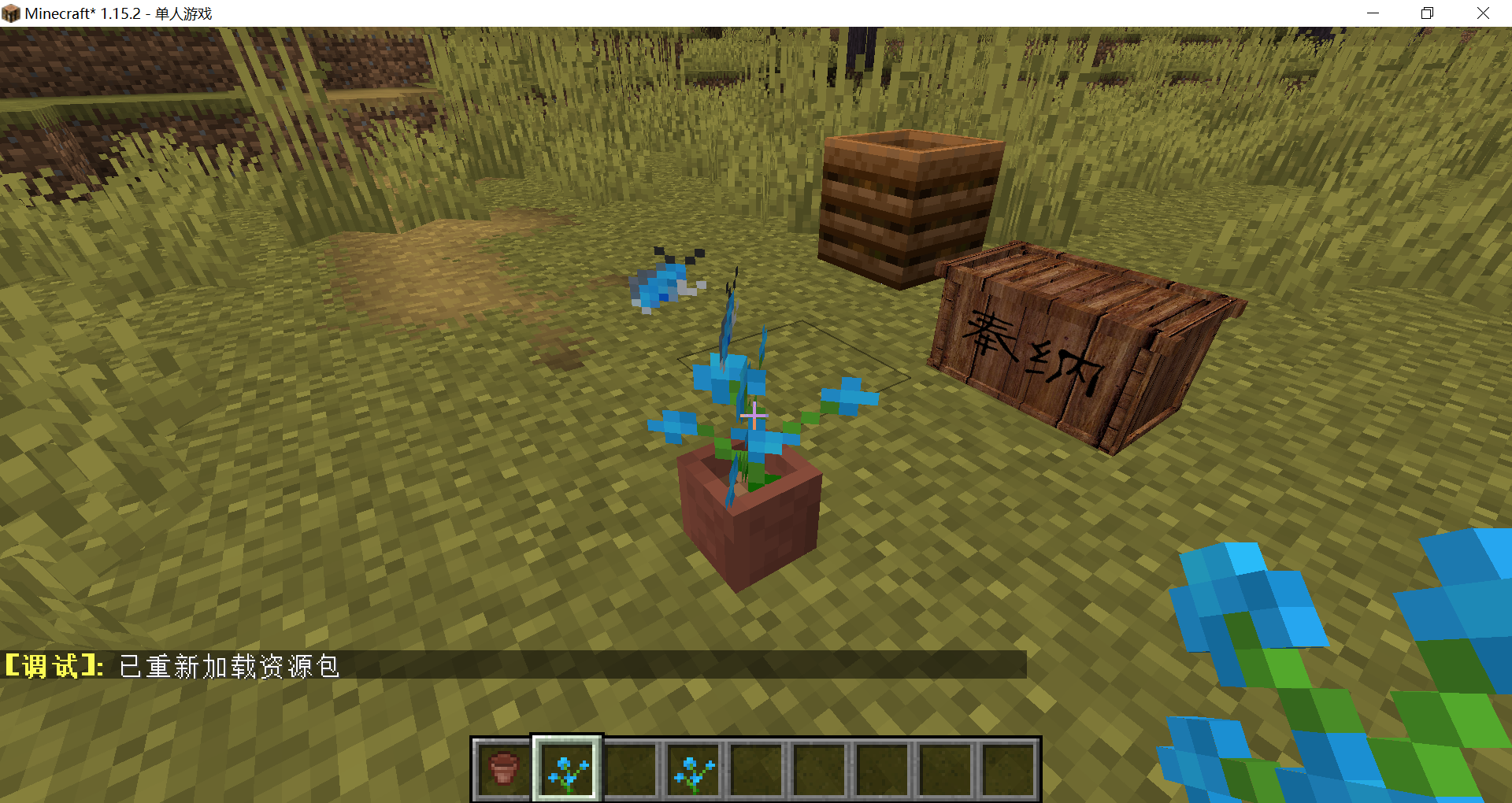# 蝶舞——盆栽艺术
前置知识:
json的语法
蝴蝶的动态纹理模仿了conquest资源包
我们的目标是制作如下效果:
首先准备好蝴蝶的动态纹理:

本节中我们要试着不使用Blockbench,徒手修改一下模型文件,以加深对模型文件本身的理解。
potted_blue_orchid.json
{
"parent": "block/flower_pot_cross",
"textures": {
"plant": "block/blue_orchid"
}
}
我们看到兰花盆栽的模型是继承了flower_pot_cross的,要在兰花上添加一对飞舞的蝴蝶,必须要修改flower_pot_cross.json。修改思路是把花盆中的花的模型复制一份,向上平移一段距离。
因为我们只想修改兰花盆栽,为了避免影响到其他盆栽,我们将文件复制一份,改个名叫flower_pot_butterfly.json,并令potted_blue_orchid继承flower_pot_butterfly。
flower_pot_butterfly.json
{
"ambientocclusion": false,
"textures": {
"particle": "block/flower_pot",
"flowerpot": "block/flower_pot",
"dirt": "block/dirt"
},
"elements": [
...
{
"from": [ 2.6, 4, 8 ],
"to": [ 13.4, 16, 8 ],
"rotation": { "origin": [ 8, 8, 8 ], "axis": "y", "angle": 45, "rescale": true },
"faces": {
"north": { "uv": [ 0, 0, 16, 16 ], "texture": "#plant" },
"south": { "uv": [ 0, 0, 16, 16 ], "texture": "#plant" }
}
},
{
"from": [ 8, 4, 2.6 ],
"to": [ 8, 16, 13.4 ],
"rotation": { "origin": [ 8, 8, 8 ], "axis": "y", "angle": 45, "rescale": true },
"faces": {
"west": { "uv": [ 0, 0, 16, 16 ], "texture": "#plant" },
"east": { "uv": [ 0, 0, 16, 16 ], "texture": "#plant" }
}
}
]
}
忽略我们不需要修改的部分,我们注意到最后两个element的纹理为#plant,而且绕y轴的旋转角度都是45度,表明它们是盆栽中花的交叉模型。
于是我们复制这两个element,粘贴到后边,接下来只展示这两个element的代码:
{
"from": [ 2.6, 4, 8 ],
"to": [ 13.4, 16, 8 ],
"rotation": { "origin": [ 8, 8, 8 ], "axis": "y", "angle": 45, "rescale": true },
"faces": {
"north": { "uv": [ 0, 0, 16, 16 ], "texture": "#plant" },
"south": { "uv": [ 0, 0, 16, 16 ], "texture": "#plant" }
}
},
{
"from": [ 8, 4, 2.6 ],
"to": [ 8, 16, 13.4 ],
"rotation": { "origin": [ 8, 8, 8 ], "axis": "y", "angle": 45, "rescale": true },
"faces": {
"west": { "uv": [ 0, 0, 16, 16 ], "texture": "#plant" },
"east": { "uv": [ 0, 0, 16, 16 ], "texture": "#plant" }
}
}
首先我们希望它使用与盆栽里的植物不同的纹理,所以将"#plant"更改为"#butterfly"。
此外,"from"和"to"表示了三维空间中的一对坐标,要修改y轴坐标的值,让模型向上移动。我们先移动6个像素,看看情况。
于是我们把这两个元素修改成这样:
{
"from": [ 2.6, 10, 8 ],
"to": [ 13.4, 22, 8 ],
"rotation": { "origin": [ 8, 8, 8 ], "axis": "y", "angle": 45, "rescale": true },
"faces": {
"north": { "uv": [ 0, 0, 16, 16 ], "texture": "#butterfly" },
"south": { "uv": [ 0, 0, 16, 16 ], "texture": "#butterfly" }
}
},
{
"from": [ 8, 10, 2.6 ],
"to": [ 8, 22, 13.4 ],
"rotation": { "origin": [ 8, 8, 8 ], "axis": "y", "angle": 45, "rescale": true },
"faces": {
"west": { "uv": [ 0, 0, 16, 16 ], "texture": "#butterfly" },
"east": { "uv": [ 0, 0, 16, 16 ], "texture": "#butterfly" }
}
}
回到 potted_blue_orchid.json
{
"parent": "block/flower_pot_butterfly",
"textures": {
"plant": "block/blue_orchid",
"butterfly": "block/butterfly_blue"
}
}
进入游戏查看效果:

完成!
提示
花盆曾经是方块实体,每种类型的盆栽对应一种方块状态,在1.13扁平化更新中被拆分成了许多独立的方块。
← 物品标签——添加更多物品 额外的资源文件 →